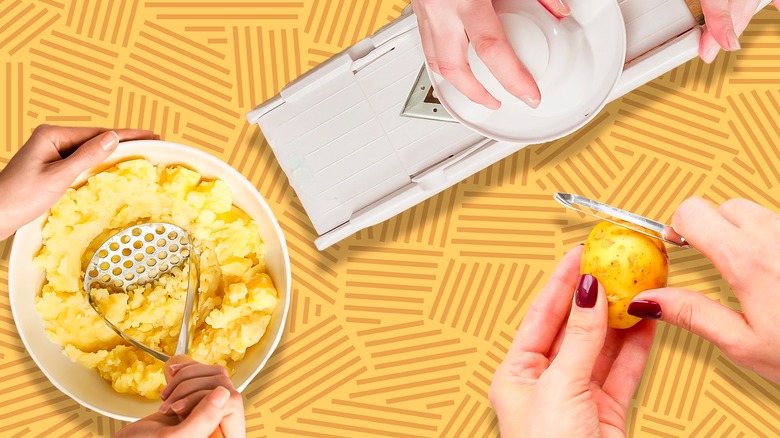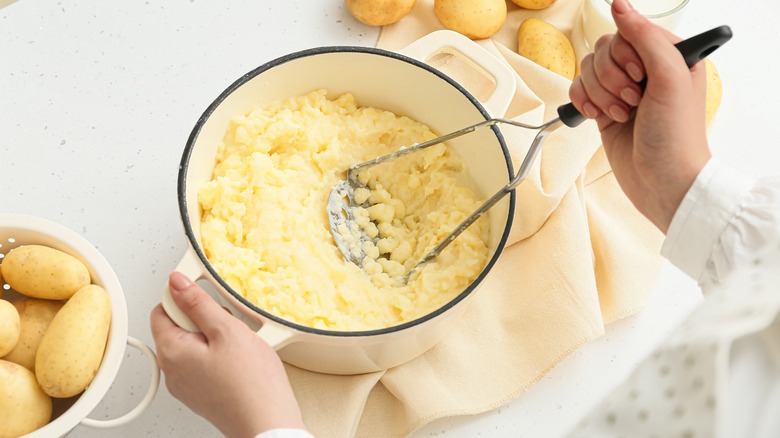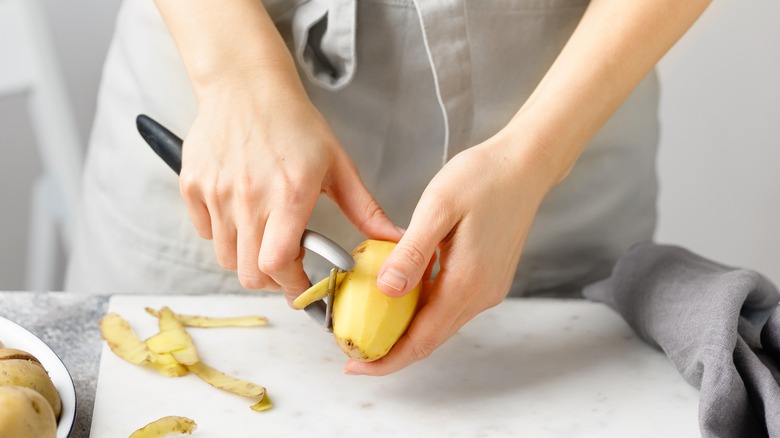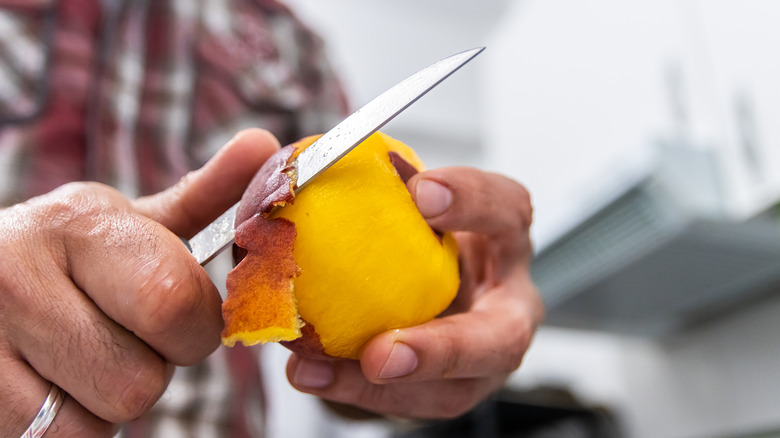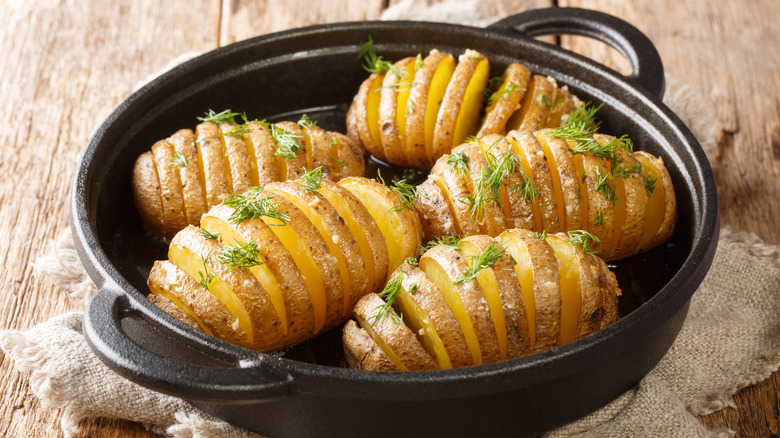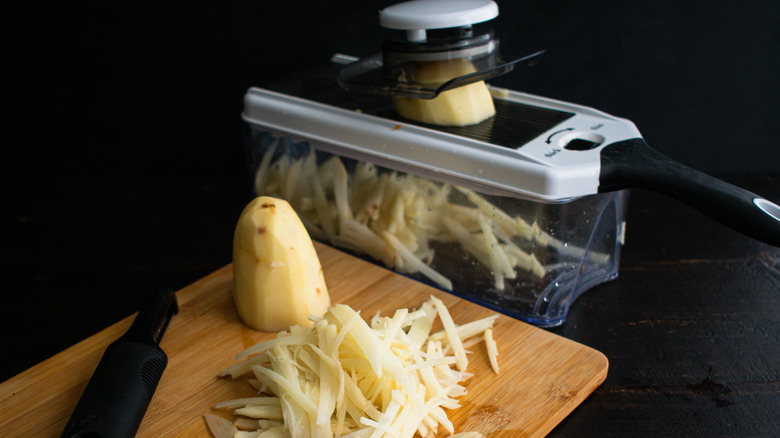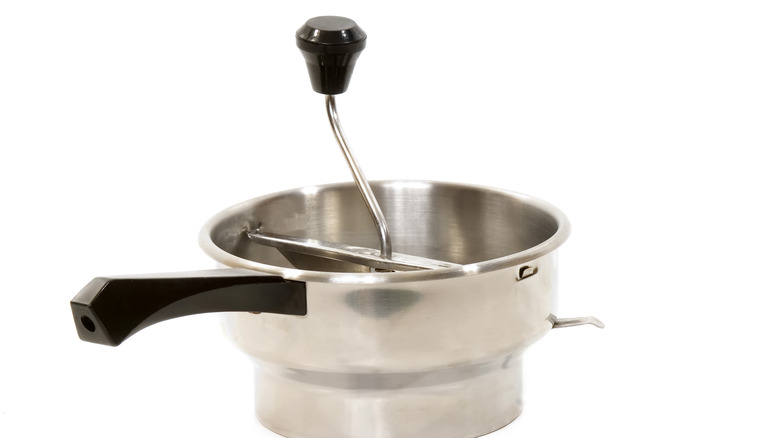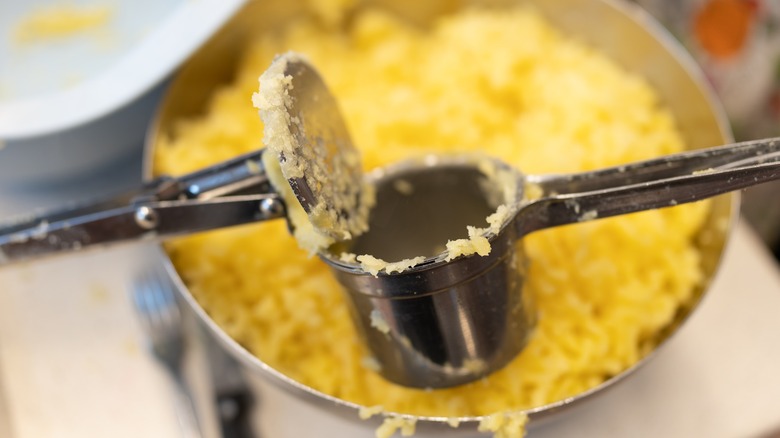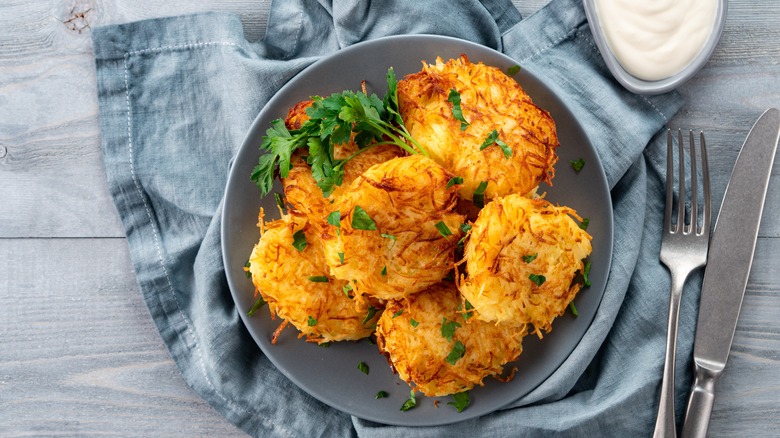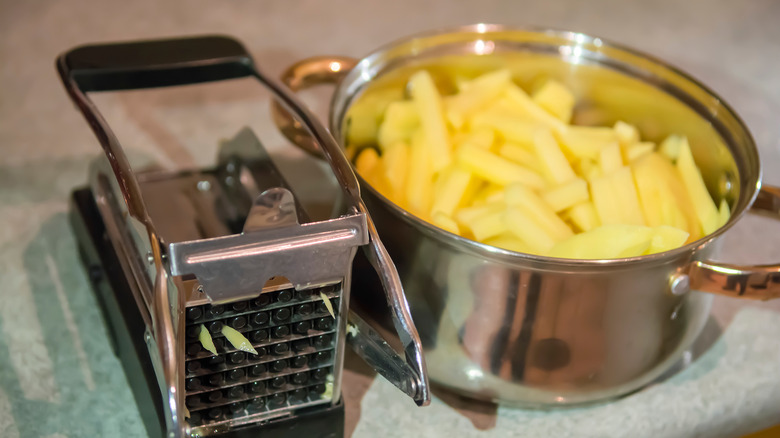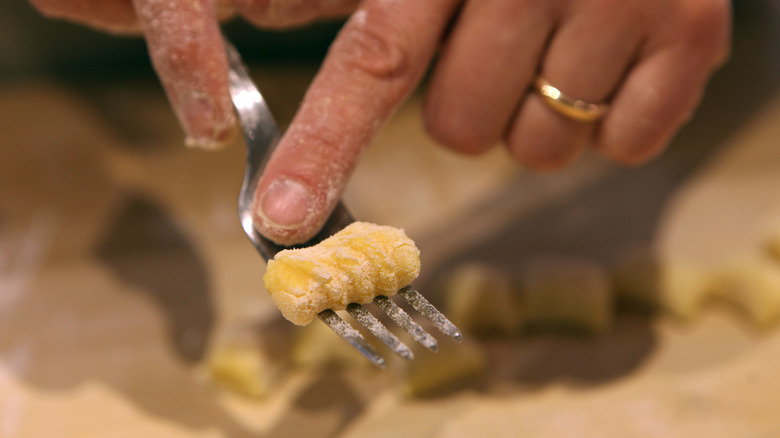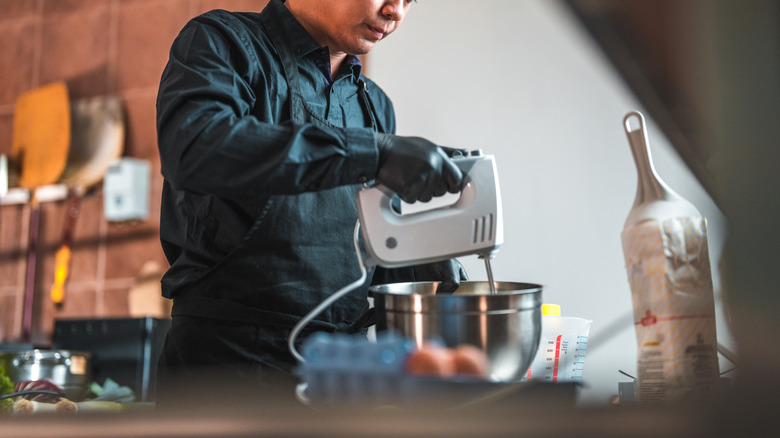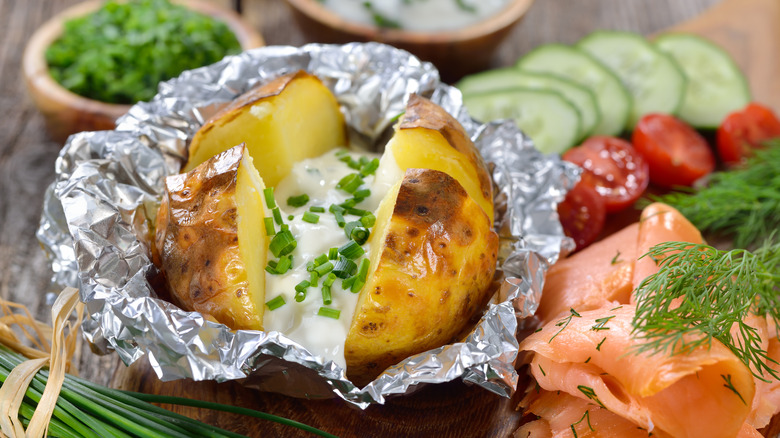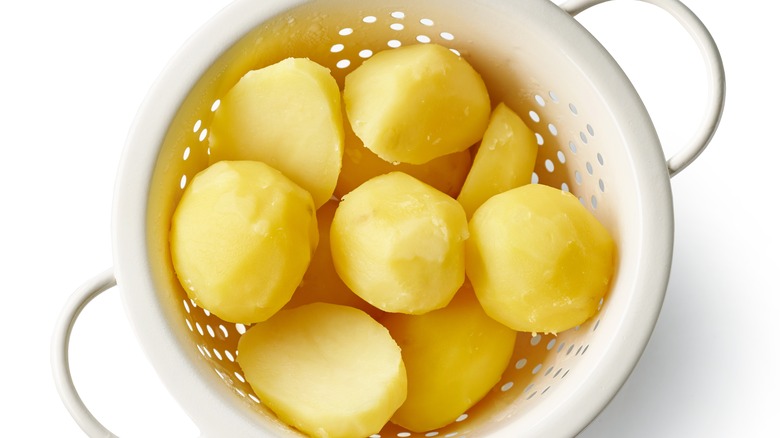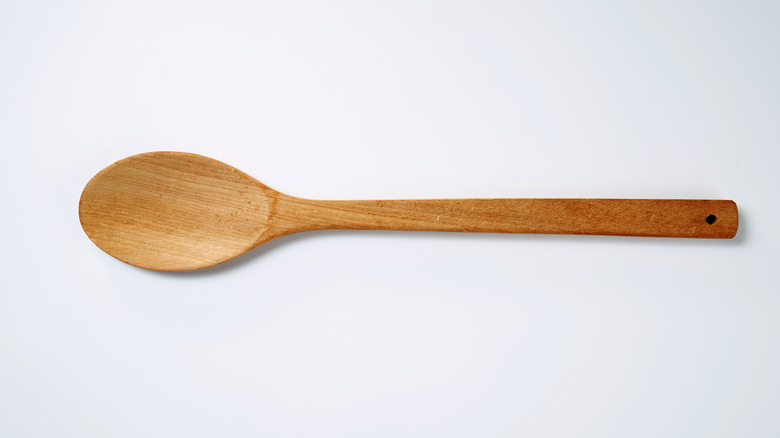14 Best Kitchen Tools You Need For Cooking With Potatoes
Potatoes are the Swiss army knife of the food world. Across cultures, potatoes are prepared in myriad ways, with endless combinations and preparations making the most of their starchy goodness. Eastern European pierogies, Spanish patatas bravas, Bombay potatoes, and more all have the unifying element of the potato, yet with so many iterations comes the challenge: how to be equipped to prepare them all, and prepare them all right?
Though such a deeply established part of the diets of so many cultures, potatoes are not inherently foolproof. Some dishes take a careful hand and a precise touch, and to accomplish the desired effect, one must have the right tools. But what are the right kitchen tools for cooking potatoes? The right tools for potatoes depend not only on the dish, but also on the preference of preparation, time on hand, and more factors. Whether you like to use a ricer for your mashed potatoes, grate your own flaky latkes, or lose yourself to the pleasures of a loaded baked potato, the tools you use make all the difference to get the most out of one of the world's favorite ingredients.
Hand masher
When it comes to tools, sometimes the simpler, the better. Sometimes the more old-fashioned, the better, as well. Such is the case with the tool to use when preparing that staple of Thanksgiving tables and restaurant menus alike: mashed potatoes.
There are many schools of thought regarding how best to prepare mashed potatoes. But the foolproof way to control consistency is a hand masher. The hand masher tool typically has a handle or grip, and a metal form of varying shapes at the end. These shapes can range from a circular grate (one that looks like a strainer or cheese grater) to more abstract shapes and squiggles. When looking for the best hand masher for mashed potatoes, look for one made of stainless steel. The shape of the masher depends on your preference, and how much control you'd like to have over the texture.
Hand mashers tend to leave mashed potatoes a little chunkier, but again, this all depends on the time applied to the process. This makes the hand masher a preferable tool versus an immersion blender, which, though it may be quicker, often leaves potatoes gummy and sticky. One of the best tools for cooking potatoes, the hand masher needn't be used exclusively for mashed potatoes. It can also be used for making the pierogi filling, and even mashing other vegetables, like avocados and tubers. For potatoes and beyond, the hand masher is a kitchen essential.
Vegetable peeler
The skins of potatoes have many dietary benefits, from antioxidant qualities to minerals like magnesium and potassium. But as appealing as those purple and russet-colored skins look, not every dish calls for a skins-on potato preparation. Enter the vegetable peeler.
You may be familiar with a few classic varieties of vegetable peelers. One typical shape has a slingshot look to it; another features a small, rounded blade with a plastic or rubber cleft. But there are also other shapes to help circumnavigate the potato while peeling it. A newer variety with a U-shaped design can be effective for roots like potatoes, carrots, and more, while a peeler with a shaving razor-like design offers the advantage of an angled neck.
To prepare potatoes that require the skins off, use a vegetable peeler when the potato is tough, solid, and firm. Recipes that take skins off can include roasted potatoes and boiled potatoes. But since each variety of potato has a different skin texture and taste, ultimately, it's a matter of preference that a vegetable peeler can help execute. Plus, one can always use a peeler for treats made from the potato skins themselves.
Paring knife
The vegetable peeler may make the paring knife seem, at first glance, redundant. But to some, the paring knife is the unequaled kitchen tool that you need to cook potatoes. Though not monumentally different from a vegetable peeler, a paring knife has its own set of advantages in the kitchen.
Essentially a smaller version of a chef's knife, paring knives have a sharp blade and short handle. They are often used for cutting fruit and those ingredients with a softer, more impressionable surface. Yet at the same time, they're great for harder vegetables like potatoes.
Though possibly the more tedious and time-consuming way to remove the skins, as well as bruises and blemishes, from a potato, the thickness of the cut and the accuracy of the cut with a paring knife can't be beat. Make sure to watch your work, though, given the sharp blade and lack of protection that its counterpart, the vegetable slicer, would offer.
Potato slicing rack
A great tool exists for those who want to go about slicing their potatoes atypically: the potato slicing rack. A potato-slicing rack isn't the most common tool to be found in kitchens. But as far as tools for prepping potatoes go, this mini-slicing station is an efficient, consistent tool.
The potato slicing rack is a potato-shaped gadget with slicers that create a beautiful, fanned effect. The most common use for a prep tool like this is for Hasselback potatoes, otherwise known as Potato à la Hasselbacken. Though the dish is somewhat common, it is not omnipresent; Hasselback potatoes are a simple baked or roasted way to prepare Yukon Gold or other potatoes that may have origins at the Swedish restaurant Hasselbacken in the 1940s or 1950s.
The divine thing about Hasselback potatoes is their options for toppings and fillings, all possible because of the halfway-through slices made by the potato slicing rack. Look for a potato slicing rack with studs to keep your spuds secure, and one with a wooden base.
Mandoline slicer
When it comes to preparing not just potatoes, but food, period, few kitchen tools outdo the mandoline slicer. This kitchen tool consists of a smallish blade attached to a usually (but not necessarily) rectangular base. The handheld tool makes it incredibly easy to slice any number of vegetables thinly and uniformly.
Mandoline slicers come in a variety of thicknesses and price points. While some cheese graters have a side that essentially operates as a mandoline slicer, there are also slicers from brands like OXO that offer many ways to mandoline in one tool. It depends on the quality and versatility of the slicer.
But what potato dishes can you cook with a mandoline slicer tool? There are so many ways to utilize a thinly sliced potato, a better question might be what can't you use mandoline slicers and potatoes for? That being said, some of the most common preparations are potato thins, potatoes au gratin, and even potato chips. One needn't stay in the conventional potato realm for these preparations: Sweet potatoes will slice on a mandoline as well, working for a different kind of chip, a pavé, or a scalloped preparation.
Food mill
As is evidenced by the number of tools you can use to prepare potatoes, there is more than one effective way to skin the proverbial cat. Case in point? Mashed potatoes. One excellent option for creating a comfort food staple is the food mill.
Though it sounds quite industrial, the food mill is a kitchen tool simply used to mash, sieve, and grind foods and looks like a pot with an attached handle. When you turn the handle, a curved metal blade pushes the ingredient inside down into a perforated or holed bottom. Among the foods one can prepare are applesauce, jelly, and even potato-based dishes. Boiled potatoes are soft enough to be transformed into a desired consistency using a food mill. Russet or Yukon potatoes are generally the best kinds of spuds to use with a food mill, and the results can be used for mashed potatoes, gnocchi, pierogi filling, and more.
Potato ricer
Another tool that can be used to transform potatoes into a desired mashed consistency is the potato ricer. The potato ricer looks like a pot with two handles. One places cooked potatoes (or other cooked vegetables) inside the pot and clamps down the ricer handles to push the potatoes through the grate. Different ricers have different fineness levels, making the ideal consistency of mashed potatoes as easy (and challenging) as choosing the right ricer for your tastes.
Though great for mashed potatoes, the real star of the ricer is gnocchi. These little Italian potato dumplings often benefit from a fine, light texture that is easier to achieve with a ricer than with a food mill or hand masher. The drawback is that ricers typically can only take on one potato at a time, so it may not be the choice for grand-scale meal prep. But as with potato preparation, the tools you use are inevitably a matter of personal preference.
Cheese grater
When analyzing what you need to succeed in the kitchen, as far as potatoes are concerned, the humblest of tools can prove to be of the most use. A common metal cheese grater, for instance, can have abundant uses when cooking potatoes. If you've ever purchased a bag of frozen hash browns from the supermarket, odds are they came in one of two shapes: cubed or grated. Starting off your day with homemade grated hash browns is an easy upgrade for breakfast. Plus, frozen varieties tend to already come in oil, making this a potentially healthier, or at least more controlled, way to consume browns.
Latkes are another common and easy way to utilize the grater in the kitchen with your potatoes. Using Yukon potatoes, grated latkes, or potato pancakes, are a fabulous side dish and a staple of the Jewish culinary tradition. This recipe for the classic Passover dish kugel offers another way to utilize grated potatoes, as well.
French fry cutter
Consider the tools needed to make good French fries. It's true that one might need nothing more than a knife. But whether you want to level up your consistency or sheer output, the French fry cutter is an uncommon, but highly advantageous tool for the french fry faithful.
This tool generally consists of a slot in which to put your potato, a handle on which you push down, and a metal grid through which the potato gets pushed. This process produces uniform potato lengths in just a movement or two. Look for a stainless steel variety, and consider using the classic restaurant potato varieties that will hold up through the grate, instead of those that might get smushed up in the process.
As with many of the other tools used to prepare and cook potatoes, the french fry cutter is available at multiple price points. It also comes in several thickness settings, so those who prefer a steak-thick experience and those who prefer theirs à la shoestring will all find something that suits them.
Fork
The most essential tools in the kitchen are sometimes the ones hiding in plain sight. The fork, in all its varieties, is a tool whose importance in preparing potatoes cannot be overstated. And, of course, in the consumption of your immaculately prepared potato creations.
There are certainly ways to get potato-specific with your forkware, however. Forks tailor-made to ease and perfect the art of cooking the potato can be found as accessible as on Amazon and as niche as in specialty cookware shops. The brand Rösle makes stainless steel forks with three prongs intended to hold potatoes properly while peeling them while they're hot. A universal two-pronged fork is also a useful tool with some potato dishes, like aiding the prep and serving of baked potatoes and larger casserole-type potato dishes.
But in the end, a quality, standard four-pronged fork will do for so many of the processes in preparing potatoes. From forming gnocchi, testing potato innards' readiness, and arranging thin potato slices for cooking, there's no way to go wrong with the fork.
Hand mixer
Again, simplicity sometimes reigns. A hand mixer is a staple of kitchens for dozens of uses, like baking, mixing, whipping, fluffing, and more. By nature versatile, like the potato, the hand mixer is the ultimate kitchen companion when considering preparation.
Back to mashed potatoes. As a ubiquitous dish, the home cook (and indeed the professional chef) is always searching for ways to improve and perfect. The hand, and even the stand, mixer gets one pretty close to that goal. Though the texture of potatoes mashed with a hand mixer is not flawlessly smooth when compared to the airy lightness of, say, a ricer or food mill, it's close enough if time and effort are your impetus.
As with other tools that mash and grind, the hand mixer can be used for a number of potato dishes. Try using leftover mashed potatoes for a potato croquette snack. You could veer Japanese for a Korokke (a potato hot dog sandwich mashup), or go a little more Spanish with croquette tapas, based on mashed potatoes made with a hand mixer.
Aluminum foil
It wouldn't be a potato tool roundup without the accouterments used to make the baked potato. The foil-wrapped spud is just about the most delicious vessel, side, or as-is main attraction that potato kind can produce. The other major aspect to their credit? Baked potatoes are also one of the easiest to prepare, thanks to aluminum foil.
A foiled-baked potato need only be cleaned, drizzled in oil, wrapped in aluminum foil, and cooked. There is some contention as to whether the aluminum foil accelerates the heating process because the potato gets insulated, thus trapping the heat inside its metal swaddle. Some suggest this preparation largely steams the potato rather than baking it. If you find yourself in that camp but are still anxious to use up that whole roll, then aluminum foil comes especially in handy for potatoes cooked on the grill. But keep in mind that heavy-duty aluminum foil is best used for the grill to avoid any unfortunate tearing or spilling of the goods.
Strainer
There are several treatments one can apply to potatoes that require boiling first. Often a little boiling is in store for mashed potatoes, but waxy potatoes are also delicious just simply boiled and dressed. Naturally, you could strain the potatoes post-boiling to avoid pouring out the liquid and managing to hold back the spuds with a plate. The strainer's advantages in cooking mashed potatoes don't end at draining boiled water, however; you can also use a strainer to mash potatoes. Not all strainers are created equal for the task, however. First, you must make sure that the potatoes aren't falling apart from over-boiling.
Once boiled, though, you can gently work the cooked potato through the grate of a strainer with a spoon or spatula. The finer the mesh of the strainer, the smoother the texture of your pommes purée will be. This may present an intimidating cleanup scenario, but simply turning the strainer upside-down and scrubbing from the bottom will make this mashed potato hack worth it come cleanup time.
One great wooden spoon
In life, as in preparing potatoes, everyone should equip themself with one great wooden spoon. The great part about this tool? There are very few hard and fast rules for what that great wooden spoon should be used for and looks like.
One of the most enjoyable preparations of potatoes can be accomplished with no more than a knife and a wooden spoon as your tools. The wooden spoon is perfect for a from-scratch potato meal like, for example, a side of simple burnished potatoes created by cutting potatoes into wedges and sauteeing them in oil or butter. A wooden spoon can also be useful in the mashing of potatoes, or the prep of stovetop hash browns.
The sky's the limit, and the tool is all about personal preference. An ovular or circular spoon of walnut, beechwood, or even olivewood is a common sense choice. The sustainable cooks among us may opt for a bamboo spoon in stocking up their kitchen. Even IKEA offers wooden spoons with different shapes, prongs, and handles for you to experiment with to your heart's content.
